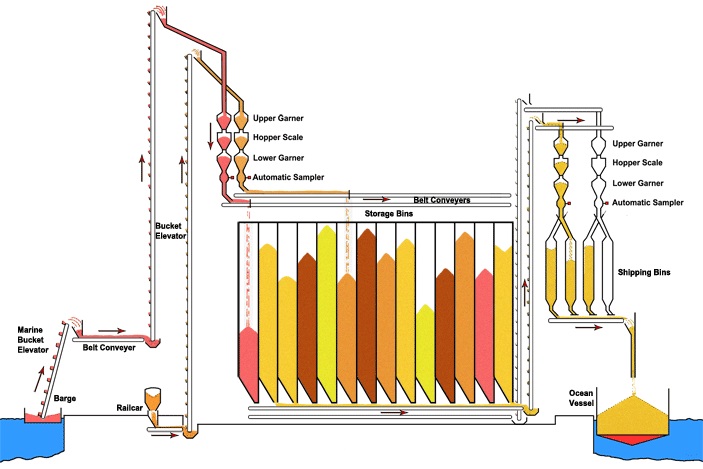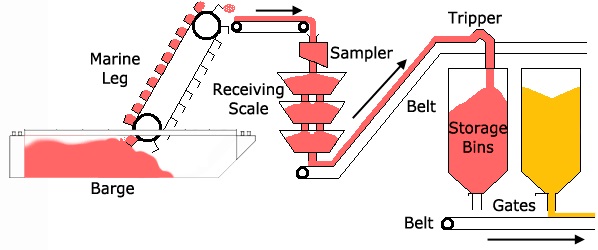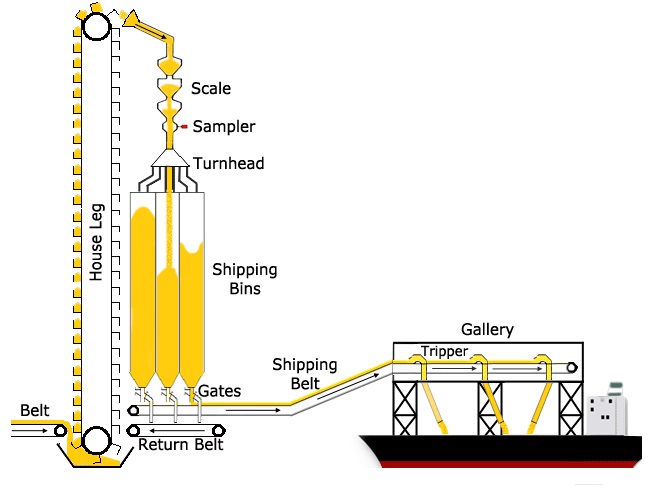
Unloading Grain From Barges
The majority of grain exported from the United States is carried by barge down the Mississippi and Columbia Rivers to export elevators, where it is unloaded and stored until it can be loaded onto ships. In addition, some grain is transferred directly from barge to ship, without being stored in an elevator. The following diagram shows commonly used equipment arranged in a typical layout, although each elevator has its own unique layout.

Loading Ships
An export elevator can load a ship with 60,000 tons of grain, worth over $30 million, in less than two days. The weight certificate must be very accurate, due to the large sums of money involved. GIPSA typically has teams of 3-5 people to inspect and weigh that grain: a shift supervisor, a weigher, a sampler, a grader, and protein analyst or mycotoxin tester.
An order of grain to be loaded aboard a ship, referred to as a "lot", is divided into smaller units called "sublots" for inspection purposes. A sublot which does not pass inspection, referred to as a "material portion," is not allowed to be loaded onto the ship. Grain is Inspected by sublots rather than waiting for the entire lot to be loaded so the lot will be of uniform quality. A lot is often divided among several customers at its destination, so it is important for no customer to be stuck with a pocket of bad grain. Also, a pocket of bad grain could spoil during the voyage and contaminate the rest of the shipment.
Every elevator has a different layout. The grain is weighed, sampled, and held in a shipping bin while it is being graded. Grain which has passed inspection is loaded onto a ship.

Terms and Definitions
BARGES: Barges carry most of the grain bound for export elevators in the United States. About 60 percent of this grain is carried on the Mississippi River alone.
BULK-WEIGHING SCALE: A bulk weighing scale weighs a batch of grain in a WEIGH HOPPER which sits on load cells or levers. Grain cannot flow into or out of the Weigh Hopper while the scale is recording a weight. During this time, grain flowing to the scale accumulates in another hopper, the UPPER GARNER, directly above the Weigh Hopper. After the weight is recorded, the Weigh Hopper dumps its grain into a LOWER GARNER, which releases it at a rate which will not overload the conveyor belts underneath. Grain enters the Weigh Hopper through SLIDE GATES at the bottom of the Upper Garner and leaves through slide gates at the bottom of the Weigh Hopper. The operation of the gates is controlled by a computer (SCALE CONTROLLER), which also records weights and generates an alarm if it detects a malfunction.
DIVERTER-TYPE (D/T) SAMPLER: The D/T, located either before or after the scale, sweeps a sampling container (called a pelican) through the grain stream once every sampling period, which is usually set between 12 and 25 seconds. The grain sample flows through a pipe to the inspection lab, where it is graded.The law requires grain arriving by barge at an export elevator to be officially weighed. However, official inspection of this grain is optional.
GALLERY: The gallery is the structure above a ship berth containing conveyor belts and spouts for loading grain into the holds of a ship. An operator sits in the gallery and controls the loading operation. Often an elevator can load grain into several holds simultaneously. Ship loading is a precision operation. The ship must not be under-loaded or over-loaded, and the load must be balanced so the ship will be stable on the long ocean voyage.
GATES: Gates control the flow of grain in an elevator. Every storage bin has a proportional slide gate underneath it to regulate the flow onto a conveyor belt. By simultaneously opening the gates on several bins by precise amounts, the elevator can blend grain to meet the grade specified in the contract.
INCLINED BELTS: Inclined belts are the preferred way to elevate grain when it must also be moved horizontally. A belt causes less damage to the grain than a leg and generates less dust. Dust must be controlled in grain elevators to prevent fires and explosions and maintain the quality of the air near the facility.
LEG: A LEG (also called a BUCKET ELEVATOR) is a vertically-oriented conveyor belt with scoops bolted to it, used to elevate grain.
MARINE LEG: A marine leg is a steeply-inclined conveyor belt with scoops bolted to it, used to scoop grain out of a barge and elevate it. An operator can move the leg around while it is running to reach most of the grain in the barge. A front-end loader can be placed in the barge to push grain which is out of reach over to the leg. Some facilities finish unloading barges with a vacuum system.
SHIPPING BIN: A shipping bin holds grain which has been weighed and is being graded. Once the grain passes, it can be sent directly to the ship. If the grain does not pass, it must be returned to the elevator. Some elevators load grain directly to the ship, without using shipping bins. At these elevators, a sublot of grain is graded after it has been loaded. If it does not make grade, the elevator has to get a clamshell rig and unload that sublot from the ship. The expense of this operation explains the popularity of shipping bins. Grain returned to the elevator is not wasted. Usually it is cleaned and mixed with better grain so it will pass inspection, then submitted as another sublot.
SHIP HOLD: A ship hold is a space for carrying cargo. Ship holds must be examined before loading by GIPSA or the delegated state agency to ensure they are free of moisture, rust, loose paint, rodents, insects, odors, or any other contamination.
STORAGE BINS: Storage bins hold large quantities of grain, sorted by type of grain and grade, until it is needed to fill an order.
TRIPPER: A tripper is a structure that removes grain from a conveyor belt. It can be moved along the belt to remove grain at different positions.
TURNHEAD: A turnhead is used in some facilities to direct grain from a single inlet duct to any one of several outlet ducts. The entrances to the outlet ducts are arranged in a circle, and the inlet duct is mounted on a shaft so its discharge opening can be rotated over the desired outlet.
Related topics
- Operation of an Bulk Weighing Scale
- Operation of a Diverter Type sampler
- Electronic Monitoring and Control Systems
- Testing a Bulk Weighing Scale
- Virtual Reality Models

